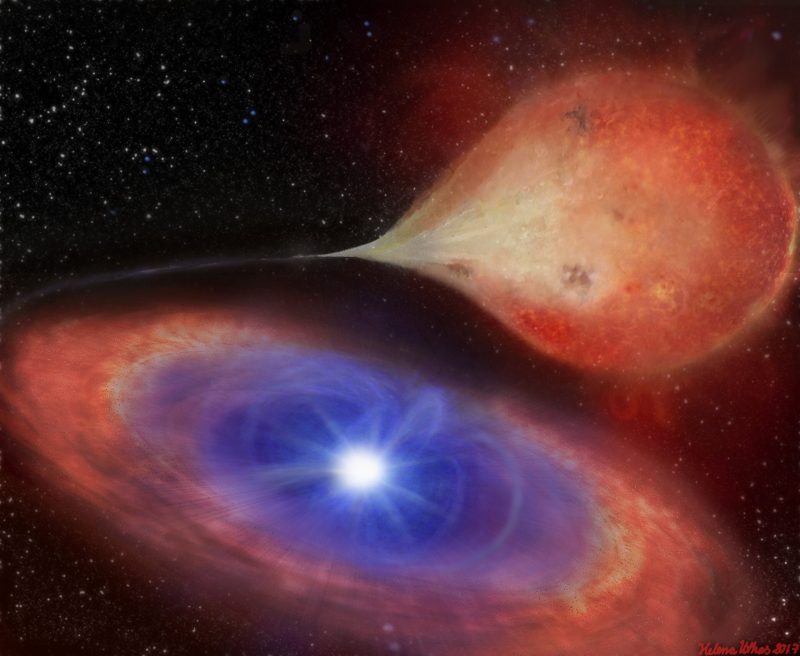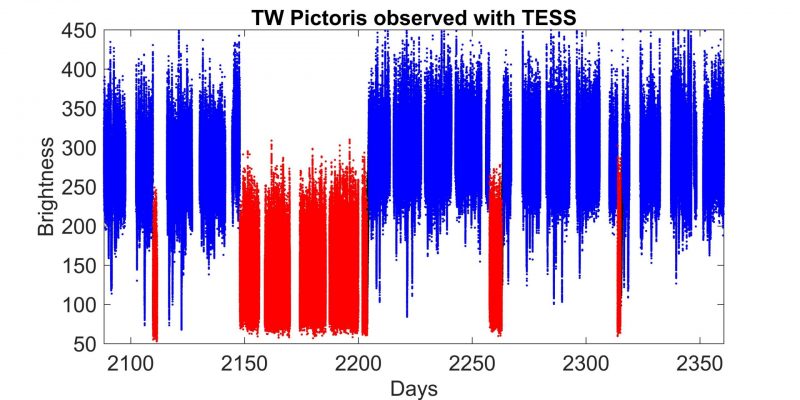
White dwarf rapid brightness change
Astronomers in the U.K. said this week that, for the first time, they saw a white dwarf star abruptly switch on and off. The star is TW Pictoris – 1,400 light-years from Earth – already known as a variable star. But its previous brightness changes were seen to happen over days or months. This time, astronomers saw the star suddenly dim and brighten again over the course of just 30 minutes. What happened to cause such a rapid shift?
A white dwarf star is a main-sequence star (a star like our sun) that has shrunk because it’s at the end of its life. The TW Pictoris system includes a white dwarf, plus a small companion star that the white dwarf “feeds” on. The white dwarf pulls in material from the companion. It’s this gradual accretion (build up) of material that causes the dwarf to change its brightness.
The scientists, led by researchers from Durham University in the UK, used a planet-hunting satellite – NASA’s Transiting Exoplanet Survey Satellite (TESS) – to make their discovery. Lead author Simone Scaringi of Durham University said:
The brightness variations seen in accreting white dwarfs are generally relatively slow, occurring on timescales of days to months. To see the brightness of TW Pictoris plummet in 30 minutes is in itself extraordinary, as it has never been seen in other accreting white dwarfs and is totally unexpected from our understanding of how these systems are supposed to feed through the accretion disk. It appears to be switching on and off.
The scientists published their study on October 18, 2021, in the peer-reviewed journal Nature Astronomy.
The force behind the white dwarf’s light switch
The scientists had to solve the puzzle of why this change from bright to dim and back was occurring. The flow of material from the accretion disk into the white dwarf is fairly steady and shouldn’t cause such a drastic change. Scientists believe the culprit for the rapid change in brightness is due to a reconfiguration of the white dwarf’s magnetic field.
They think that when the white dwarf’s light switch is in the “on” position, brightness is high and the white dwarf is feeding normally on the accretion disk. When the white dwarf suddenly dims – turning the switch to off – the star’s magnetic field changed, interrupting the flow. As the scientists explained in their press release:
The magnetic field is spinning so rapidly, it creates a barrier disrupting the amount of food the white dwarf can receive – a process called magnetic gating. This leads to semi-regular small increases in brightness seen by the astronomers. After some time, the system sporadically turns “on” again, and the brightness increases back to its original level.
The white dwarf’s spinning magnetic field is acting as a gate. Occasionally the reconfiguration of the magnetic field causes a gate to come down, temporarily cutting off the food supply and resulting in the brief dimming. Then the white dwarf begins to feed and glow brightly again.

From a white dwarf to a black hole
The astronomers hope their discovery will tell them more about the process of accretion, an activity also undertaken by black holes and neutron stars. As Scaringi said:
This really is a previously unrecognized phenomenon, and because we can draw comparisons with similar behavior in the much smaller neutron stars, it could be an important step in helping us to better understand the process of how other accreting objects feed on the material that surrounds them and the important role of magnetic fields in this process.

Bottom line: Astronomers have witnessed a white dwarf switching on and off over a period of just 30 minutes. This rapid change in brightness could teach them more about accretion.
Source: An accreting white dwarf displaying fast transitional mode switching











